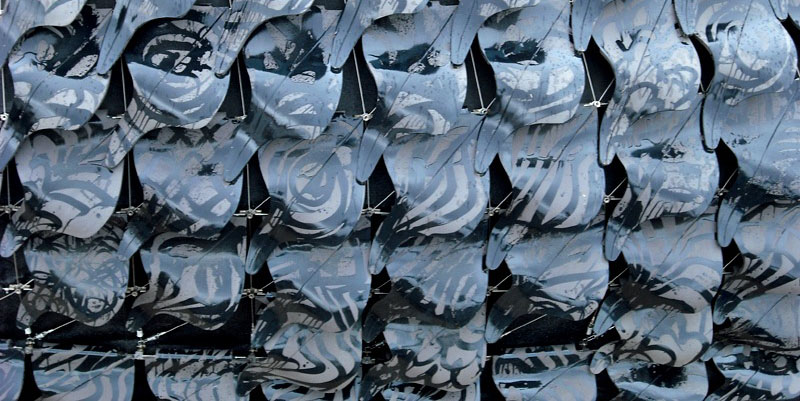This article continues CFile’s look at this centuries most exciting collaborations between ceramics and architecture. Enric Ruiz-Geli’s Villa Nurbs, located in the coastal town of Empuriabrava on the Costa Brava, Spain, is one of those love-it or hate-it buildings; regardless, every architect who comes to town wants to see it. The mixture of ceramics and plastics optimizes the surface and structure, which is important for the temperature regulation inside the house. The wavelike ceramic plates decorate the facade and protect against strong solar radiation. The energy-saving roof consists of inflatable plastic bubbles. It was designed in collaboration with artist Frederic Amat (who designed the tiles) and ceramist Toni Cumella (who produced them, see video). The space age has arrived, but it is still a work in progress.
The best writing on this controversial structure comes from Justin McGuirk for Icon Magazine Online, written with just the right blend of skepticism and awe,
Inside this sanctum will be a world of ubiquitous technology, but one swept clean of technical clutter. With one decisive gesture, Ruiz-Geli removed all the machinery that permeates the modern home into a solar-powered shed in the garden. The motors running the fridge, the kitchen extractor fan and even the vacuum cleaner will be housed in that shed, connected to the house by underground pipes. With the “hardware” removed to this centralised engine room, the house is left to be pure interface. There won’t even be any light switches, just sensors. Ruiz-Geli likens the shed to the astronaut’s backpack, a life-support system removing the whir of technology to preserve the silence of space. As in the theatre, gadgetry clears the stage for the smooth performance of everyday life.
All of this has the ring of a Jacques Tati film, like the ludicrous modern house in Mon Oncle, with the latest in dysfunctional mod cons. It’s almost nostalgic for bygone futures. Think of Suuronen’s Futuro House or Buckminster Fuller’s Dymaxion House and their dreams of space age living. Just as they were distinctly vehicular, Ruiz Geli describes Villa Nurbs as “a bridge between car and boat”. But its predecessors never caught on. Perhaps it’s because designing a house like a car dooms it to rapid obsolescence. What if we want to change the fridge or the vacuum cleaner?
In McGuirk’s opinion, Villa Nurbs’ savior (which is similar to the critical judgment on Renzo Piano’s St. Giles Building in London) is ceramics; “It may be a blob, incubated in the floating space of the computer screen, but those black ceramic tiles give it a distinctly Spanish sensibility. Created by artist Frederic Amat, they’re like dragon scales. It seems ironic that the craft aspect contributes more to the building’s monstrousness than its alien-style digital modelling. But, in this Floridian setting, it is the house that seems sane and the conformity around it that is monstrous.”
Villa Nurbs is hardly an anomaly in Ruiz-Geli’s oeuvre. Visit his site and see some of the most imaginative, free form architectural ideas in the profession.










Architect Enric Ruiz-Geli’s Villa Nurbs, a private residence that is in-progress as of 2013 and located on the Costa Brava, Spain. It was designed in collaboration with artist Frederic Amat, who designed the tiles, and ceramist Toni Cumella who produced them. Images courtesy of Enric Ruiz-Geli
This video by artist Frederic Amat, Villa Nurbs, beautifully documents the progression of Villa Nurbs, a private residence by architect Enric Ruiz-Geli that is located on the Costa Brava, Spain. It highlights the creation of the building’s ceramic tiles that were designed by Amat and produced by ceramist Toni Cumella.
Read Justin McGuirk’s piece on Villa Nurbs

That is very fascinating, You’re an excessively skilled blogger.
I’ve joined your feed and stay up for looking for more of your wonderful post.
Additionally, I’ve shared your website in my social networks
Thanks much!